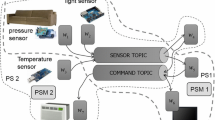Abstract
For the ubiquitous computing environment, an important assumption is that all the components in any specific environment are connected with each other. With this assumption, we introduce an effective scheme to provide a personalized service based on Virtual Personal World (VPW). Virtual Personal World (VPW) which is a model focused on service continuity with specially designed components. Previous ubiquitous frameworks have been concerned with the location where a user is provided any specific service. However those questions above are not the most important problems anymore in VPW. It concentrates on the point whether the services are successive or not, wherever a user goes to any place. Services are not regarded as a sum of functions which is embedded on any objects in any certain place. We conceptually define a resource management scheme based on a unified form of the object which participates in service provision, so called virtual object (VO). Thus the service can be described as the sum of functions of VOs. With our resource management scheme, users can utilize their required object as VO wherever it is located. And also, for better utilization of VPW service, we introduce a novel form of profiles and service provision scheme based on the polymorphism. Our simulation result shows that the Ratio of VPW pure service time is 0.15 % higher than conventional location based service. And also the possibility that users can meet adequate service he wants raised 29 % in our proposed VPW environment.









Similar content being viewed by others
References
Baldauf M, Dustdar S, Rosenberg F (2007) A survey on context-aware systems. Int J Ad Hoc Ubiquit Comput 2(4):263–277
Ballagas R, Borchers J, Rohs M, Sheridan JG (2006) The smart phone: a ubiquitous input device. IEEE Pervasive Comput 5(1):70–77
Harter A, Hopper A, Steggles P, Ward A, Webster P (2002) The anatomy of a context-aware application. Wirel Netw 8:187–197
iWork Homepage, http://iwork.stanford.edu/
Mohapatra D, Suma SB (2005) Survey of location based wireless services. IEEE International Conference on Personal Wireless Communications (ICPWC2005), 358–362
Mori G, Paterno F, Santoro C (2004) Design and development of multidevice user interfaces through multiple logical descriptions. IEEE Trans Softw Eng 30(8):507–520
Park K-L, Park J-K, Kim S-D (2008) An effective model and management scheme of personal space for ubiquitous computing applications. IEEE Trans Syst Man Cybern A (SMC-A) 38(6):1295–1311
Ponnekanti SR, Lee B, Fox A, Hanrahan P, Winograd T (2001) ICrafter: a service framework for ubiquitous computing environments. In: Proceedings of the 3rd international conference on Ubiquitous Computing (UbiComp ‘01), 56–75
Roman M, Hess C, Cerqueira R, Ranganathan A, Campbell RH, Nahrstedt K (2002) Gaia: a middleware infrastructure to enable active spaces. IEEE Pervasive Comput Mag 1(4):74–82
Schilke SW, Bleimann U, Furnell SM, Phippen AD (2004) Multi-dimensional-personalisation for location and interest-based recommendation. Internet Res Electron Netw Appl Policy 14(5):379–385
Scholtz J, Consolvo S (2004) Toward a Discipline for Evaluating Ubiquitous Computing Application. Technical Report, Intel Research
Singh MP, Huhns MN (2005) Service-oriented computing semantics, processes, agents. John Wiley & Sons, Ltd., West Sussex
Weiser M (1991) The computer for the 21st century. Sci Am 265(3):66–75
Acknowledgments
This research was supported by the Basic Science Research Program through the National Research Foundation of Korea (NRF) funded by the Ministry of Education, Science and Technology (No. 2012R1A1A2043400).
Author information
Authors and Affiliations
Corresponding author
Rights and permissions
About this article
Cite this article
Hong, CP., Kim, CG., Kim, K.J. et al. A polymorphic service management scheme based on virtual object for ubiquitous computing environment. Multimed Tools Appl 74, 6183–6196 (2015). https://doi.org/10.1007/s11042-014-2090-3
Received:
Accepted:
Published:
Issue Date:
DOI: https://doi.org/10.1007/s11042-014-2090-3




